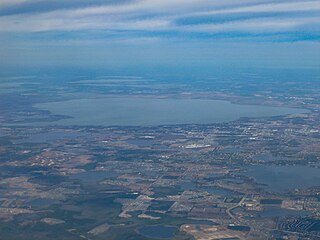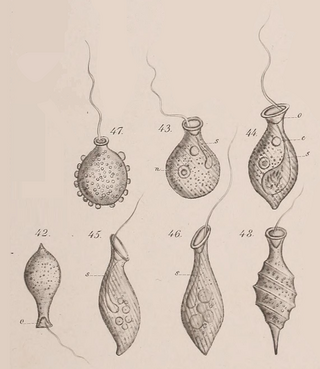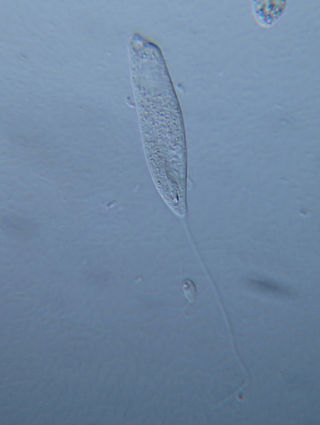
Algae are any of a large and diverse group of photosynthetic, eukaryotic organisms. The name is an informal term for a polyphyletic grouping that includes species from multiple distinct clades. Included organisms range from unicellular microalgae, such as Chlorella, Prototheca and the diatoms, to multicellular forms, such as the giant kelp, a large brown alga which may grow up to 50 metres (160 ft) in length. Most are aquatic and lack many of the distinct cell and tissue types, such as stomata, xylem and phloem that are found in land plants. The largest and most complex marine algae are called seaweeds, while the most complex freshwater forms are the Charophyta, a division of green algae which includes, for example, Spirogyra and stoneworts. Algae that are carried by water are plankton, specifically phytoplankton.

The Chlorophyceae are one of the classes of green algae, distinguished mainly on the basis of ultrastructural morphology. They are usually green due to the dominance of pigments chlorophyll a and chlorophyll b. The chloroplast may be discoid, plate-like, reticulate, cup-shaped, spiral- or ribbon-shaped in different species. Most of the members have one or more storage bodies called pyrenoids located in the chloroplast. Pyrenoids contain protein besides starch. Some green algae may store food in the form of oil droplets. They usually have a cell wall made up of an inner layer of cellulose and outer layer of pectose.

Brown algae are a large group of multicellular algae comprising the class Phaeophyceae. They include many seaweeds located in colder waters of the Northern Hemisphere. Brown algae are the major seaweeds of the temperate and polar regions. Many brown algae, such as members of the order Fucales, commonly grow along rocky seashores. Most brown algae live in marine environments, where they play an important role both as food and as a potential habitat. For instance, Macrocystis, a kelp of the order Laminariales, may reach 60 m (200 ft) in length and forms prominent underwater kelp forests that contain a high level of biodiversity. Another example is Sargassum, which creates unique floating mats of seaweed in the tropical waters of the Sargasso Sea that serve as the habitats for many species. Some members of the class, such as kelps, are used by humans as food.

Fucus is a genus of brown algae found in the intertidal zones of rocky seashores almost throughout the world.

Stentor, sometimes called trumpet animalcules, are a genus of filter-feeding, heterotrophic ciliates, representative of the heterotrichs. They are usually horn-shaped, and reach lengths of two millimeters; as such, they are among the largest known extant unicellular organisms. They reproduce asexually through binary fission.

Lake Apopka is the fourth largest lake in the U.S. state of Florida. It is located 15 miles (24 km) northwest of Orlando, mostly within the bounds of Orange County, although the western part is in Lake County. Fed by a natural spring, rainfall and stormwater runoff, water from Lake Apopka flows through the Apopka-Beauclair Canal and into Lakes Beauclair and Dora. From Lake Dora, water flows into Lake Eustis, then into Lake Griffin and then northward into the Ocklawaha River, which flows into the St. Johns River. Multiple parks or nature trails are present around the lake including Magnolia Park, Lake Apopka Wildlife Drive, Ferndale Preserve, Oakland Nature Preserve, Dr. Bradford Memorial Park, and Newton Park, named for A. B. Newton.

Dictyotales is a large order in the brown algae containing the single family Dictyotaceae. Members of this order generally prefer warmer waters than other brown algae, and are prevalent in tropical and subtropical waters thanks to their many chemical defenses to ward off grazers. They display an isomorphic haplodiploid life cycle and are characterized by vegetative growth through a single apical cell. One genus in this order, Padina, is the only calcareous member of the brown algae.

The maxima clam, also known as the small giant clam, is a species of bivalve mollusc found throughout the Indo-Pacific region.

Tetraspora is a genus of green algae in the family Tetrasporaceae of the order Chlamydomonadales, division Chlorophyta. Species of Tetraspora are unicellular green algae that exist in arrangements of four and consist of cells being packaged together in a gelatinous envelope that creates macroscopic colonies. These are primarily freshwater organisms, although there have been few cases where they have been found inhabiting marine environments and even contaminated water bodies. Tetraspora species can be found all around the globe, except in Antarctica. Despite the ubiquitous presence, the greatest growth of the genera's species is seen in the polar climatic zones.

The Trophic State Index (TSI) is a classification system designed to rate water bodies based on the amount of biological productivity they sustain. Although the term "trophic index" is commonly applied to lakes, any surface water body may be indexed.

A harmful algal bloom (HAB), or excessive algae growth, is an algal bloom that causes negative impacts to other organisms by production of natural algae-produced toxins, mechanical damage to other organisms, or by other means. HABs are sometimes defined as only those algal blooms that produce toxins, and sometimes as any algal bloom that can result in severely lower oxygen levels in natural waters, killing organisms in marine or fresh waters. Blooms can last from a few days to many months. After the bloom dies, the microbes that decompose the dead algae use up more of the oxygen, generating a "dead zone" which can cause fish die-offs. When these zones cover a large area for an extended period of time, neither fish nor plants are able to survive. Harmful algal blooms in marine environments are often called "red tides".

The twist-necked turtle, also known as the flat-headed turtle, is distributed widely across northern South America. Twist-necked turtles have extremely flat shells that help them hide from predators under rocks and debris. When threatened, this turtle withdraws by twisting its head into its shell. P. platycephala is the only species of the genus Platemys and occurs in northern and central South America. Platemys platycephala means "flat turtle, flat-head" and accurately describes the structure of the head and shell. This species inhabits shallow creek beds and frequently forages on the floor of the Amazon rainforest for insects, amphibians, and mollusks. Camouflage, head and body shape, and advanced sexual anatomy allow this species of turtle to effectively populate much of South America. Mating occurs during rainy months (March–December) and egg deposit occurs during dry months (January–March). Males have been known to behave aggressively towards females during copulation by squirting water from nostrils and biting. A few genomic studies show mosaicism exists among populations of the twist-necked turtle in Suriname. In other words, diploid and triploid levels exist among individuals at this particular location. No threats have been reported for this species and the International Union for Conservation of Nature does not have a current listing. Lack of human consumption due to the species' small size and its wide range explain why scientists are not concerned about this turtle species.

Climacostomum is a genus of unicellular ciliates, belonging to the class Heterotrichea.

Stentor roeselii is a free-living ciliate species of the genus Stentor, in the class Heterotrichea. It is a common and widespread protozoan, found throughout the world in freshwater ponds, lakes, rivers and ditches.
Petalomonas is a genus of phagotrophic, flagellated euglenoids. Phagotrophic euglenoids are one of the most important forms of flagellates in benthic aquatic systems, playing an important role in microbial food webs. The traits that distinguish this particular genus are highly variable, especially at higher taxa. However, general characteristics such as a rigid cell shape and single emergent flagellum can describe the species among this genus.
Heteronema is a genus of phagotrophic, flagellated euglenoids that are most widely distributed in fresh water environments. This genus consists of two very distinguishable morphogroups that are phylogenetically closely related. These morphogroups are deciphered based on shape, locomotion and other ultrastructural traits. However, this genus does impose taxonomic problems due to the varying historical descriptions of Heteronema species and its similarity to the genus Paranema. The species H. exaratum, was the first heteronemid with a skidding motion to be sequenced, which led to the discovery that it was not closely related to H. scaphrum, contrary to what was previously assumed, but instead to a sister group of primary osmotrophs. This suggests that skidding heteronemids can also be distinguished phylogenetically, being more closely related to Anisoma, Dinema and Aphageae, than to other species within Heteronema.
Torodinium (ˌtɔɹoʊˈdɪniəm) is a genus of unarmored dinoflagellates and comprises two species, Torodinium robustum and the type species Torodinium teredo. The establishment of Torodinium, as well as the characterization of the majority of its morphology, occurred in 1921 and further advances since have been slow. Lack of research is largely due to its extremely fragile and easily deformed nature, which also renders fossil records implausible. The genus was originally characterized by torsion of the sulcus and a posterior cingulum. Since then, new distinctive features have been discovered including an extremely reduced hyposome, a longitudinally ribbed episome, and a canal on the dextro-lateral side. Further investigation into the function of many anatomical features is still necessary for this genus.
Rhodelphis is a single-celled archaeplastid that lives in aquatic environments and is the sister group to red algae and possibly Picozoa. While red algae have no flagellated stages and are generally photoautotrophic, Rhodelphis is a flagellated predator containing a non-photosynthetic plastid. This group is important to the understanding of plastid evolution because they provide insight into the morphology and biochemistry of early archaeplastids. Rhodelphis contains a remnant plastid that is not capable of photosynthesis, but may play a role in biochemical pathways in the cell like heme synthesis and iron-sulfur clustering. The plastid does not have a genome, but genes are targeted to it from the nucleus. Rhodelphis is ovoid with a tapered anterior end bearing two perpendicularly-oriented flagella.

Urceolus cyclostomus is a species of heterotrophic flagellates. It was initially described by Friedrich Stein in 1878 as Phialonema cyclostomum, from an unknown location. Due to its morphological similarities to Urceolus alenizini, the author of the latter, Konstantin Mereschkowsky, transferred it to the genus Urceolus in 1881. Like other species of the genus, its cells have a neck and a wide aperture to a canal that hosts a single flagellum and its feeding apparatus. It is distinguished from other species by a significantly more rigid cell shape, among other traits. It can be found in the bottom sediment of freshwater and brackish water bodies, as a consumer of algae.

The peranemids are a group of phagotrophic flagellates, single-celled eukaryotes or protists. They belong to the Euglenida, a diverse lineage of flagellates that contains the closely related euglenophyte algae. Like these algae, peranemids have flexible cells capable of deformation or metaboly, and have one or two flagella in the anterior region of the cell. They are classified as family Peranemidae (ICZN) or Peranemataceae (ICBN) within the monotypic order Peranemida (ICZN) or Peranematales (ICBN).















